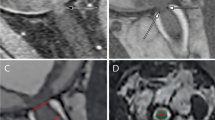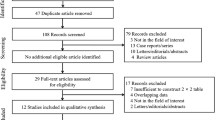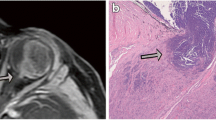Abstract
Background
Detection of optic nerve invasion is mandatory in children primarily enucleated for retinoblastoma to ensure a free resection margin.
Objective
To assess the accuracy of CT and MRI for the detection of postlaminar invasion in normal-size nerves.
Materials and methods
A total of 150 patients enucleated for retinoblastoma were included. Imaging data (119 CT and 46 MRI) were retrospectively reviewed and compared with histological findings. Abnormal contrast enhancement of the optic nerve was used as diagnostic criterion for invasion. The associations between postlaminar invasion and several indirect signs were also assessed. Statistical analysis was performed with the Kruskal-Wallis and Fisher exact tests.
Results
Postlaminar invasion on histology was observed in 8% (12/150). The sensitivity, specificity, accuracy and negative and positive predictive values were 60%, 95%, 91%, 95% and 60% for MRI, and 0%, 100%, 94% and 94% (PPV not assessable) for CT, respectively. Tumour diameter was the only indirect radiological sign significantly associated with postlaminar optic nerve invasion (P=0.002).
Conclusion
Our results suggest that MRI is more relevant than CT for preoperative detection of optic nerve invasion in patients with retinoblastoma. Tumour diameter is the only indirect sign significantly associated with postlaminar invasion.





Similar content being viewed by others
References
Doz F, Brisse H, Stoppa-Lyonnet D et al (2004) Retinoblastoma. In: Pinkerton R, Plowman P, Pieters R (eds) Paediatric oncology. Arnold, London, pp 323–338
Shields CL, Meadows AT, Leahey AM et al (2004) Continuing challenges in the management of retinoblastoma with chemotherapy. Retina 24:849–862
Shields CL, Shields JA, Baez K et al (1994) Optic nerve invasion of retinoblastoma. Metastatic potential and clinical risk factors. Cancer 73:692–698
Khelfaoui F, Validire P, Auperin A et al (1996) Histopathologic risk factors in retinoblastoma: a retrospective study of 172 patients treated in a single institution. Cancer 77:1206–1213
Magramm I, Abramson DH, Ellsworth RM (1989) Optic nerve involvement in retinoblastoma. Ophthalmology 96:217–222
Bellaton E, Bertozzi AI, Behar C et al (2003) Neoadjuvant chemotherapy for extensive unilateral retinoblastoma. Br J Ophthalmol 87:327–329
John-Mikolajewski V, Messmer E, Sauerwein W et al (1987) Orbital computed tomography. Does it help in diagnosing the infiltration of choroid, sclera and/or optic nerve in retinoblastoma? Ophthalmic Paediatr Genet 8:101–104
Jacquemin C, Karcioglu ZA (1998) Detection of optic nerve involvement in retinoblastoma with enhanced computed tomography. Eye 12:179–183
Ainbinder DJ, Haik BG, Frei DF et al (1996) Gadolinium enhancement: improved MRI detection of retinoblastoma extension into the optic nerve. Neuroradiology 38:778–781
de Graaf P, Barkhof F, Moll AC et al (2005) Retinoblastoma: MR imaging parameters in detection of tumor extent. Radiology 235:197–207
Schueler AO, Hosten N, Bechrakis NE et al (2003) High resolution magnetic resonance imaging of retinoblastoma. Br J Ophthalmol 87:330–335
Lemke AJ, Kazi I, Mergner U et al (2007) Retinoblastoma – MR appearance using a surface coil in comparison with histopathological results. Eur Radiol 17:49–60
Galluzzi P, Cerase A, Hadjistilianou T et al (2003) Retinoblastoma: abnormal gadolinium enhancement of anterior segment of eyes at MR imaging with clinical and histopathologic correlation. Radiology 228:683–690
Karim S, Clark RA, Poukens V et al (2004) Demonstration of systematic variation in human intraorbital optic nerve size by quantitative magnetic resonance imaging and histology. Invest Ophthalmol Vis Sci 45:1047–1051
Shields JA, Shields CL, De Potter P (1992) Enucleation technique for children with retinoblastoma. J Pediatr Ophthalmol Strabismus 29:213–215
Kaste SC, Jenkins JJ III, Pratt CB et al (2000) Retinoblastoma: sonographic findings with pathologic correlation in pediatric patients. AJR 175:495–501
Finger PT, Khoobehi A, Ponce-Contreras MR et al (2002) Three dimensional ultrasound of retinoblastoma: initial experience. Br J Ophthalmol 86:1136–1138
Finger PT, Garcia JP Jr, Pro MJ et al (2005) “C-scan” ultrasound imaging of optic nerve extension of retinoblastoma. Br J Ophthalmol 89:1225–1226
Aerts I, Pacquement H, Doz F et al (2004) Outcome of second malignancies after retinoblastoma: a retrospective analysis of 25 patients treated at the Institut Curie. Eur J Cancer 40:1522–1529
Kaufman LM, Mafee MF, Song CD (1998) Retinoblastoma and simulating lesions. Role of CT, MR imaging and use of Gd-DTPA contrast enhancement. Radiol Clin North Am 36:1101–1117
Mafee MF, Goldberg MF, Greenwald MJ et al (1987) Retinoblastoma and simulating lesions: role of CT and MR imaging. Radiol Clin North Am 25:667–682
Potter PD, Shields CL, Shields JA et al (1996) The role of magnetic resonance imaging in children with intraocular tumors and simulating lesions. Ophthalmology 103:1774–1783
Smirniotopoulos JG, Bargallo N, Mafee MF (1994) Differential diagnosis of leukokoria: radiologic-pathologic correlation. Radiographics 14:1059–1079
Barkhof F, Smeets M, van der Valk P et al (1997) MR imaging in retinoblastoma. Eur Radiol 7:726–731
Gizewski ER, Wanke I, Jurklies C et al (2005) T1 Gd-enhanced compared with CISS sequences in retinoblastoma: superiority of T1 sequences in evaluation of tumour extension. Neuroradiology 47:56–61
Brisse HJ, Lumbroso L, Freneaux PC et al (2001) Sonographic, CT, and MR imaging findings in diffuse infiltrative retinoblastoma: report of two cases with histologic comparison. AJNR 22:499–504
Breslau J, Dalley R, Tsuruda J et al (1995) Phased-array surface coil MR of the orbits and optic nerves. AJNR 16:1247–1251
Author information
Authors and Affiliations
Corresponding author
Rights and permissions
About this article
Cite this article
Brisse, H.J., Guesmi, M., Aerts, I. et al. Relevance of CT and MRI in retinoblastoma for the diagnosis of postlaminar invasion with normal-size optic nerve: a retrospective study of 150 patients with histological comparison. Pediatr Radiol 37, 649–656 (2007). https://doi.org/10.1007/s00247-007-0491-4
Received:
Revised:
Accepted:
Published:
Issue Date:
DOI: https://doi.org/10.1007/s00247-007-0491-4




